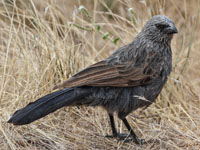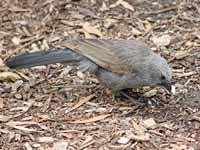BIRDS of THE WORLD - An Online Bird Book
CORVIDAE
Crows and Allies
Order Passeriformes Family Corvidae
CORVIDAE
The Corvidae family contains the crows, ravens, rooks, jackdaws, jays, magpies, treepies, choughs and nutcrackers. They are considered the most intelligent of the birds. They are medium to large in size, with strong feet and bills, and a single moult each year (most passerines moult twice). Most species have bristle-like feathers covering their nostrils. They are omnivores having a varied diet. Corvids are found worldwide except for the tip of South America and the polar ice caps. [abstracted from Wikipedia]
Crows and Allies
Order Passeriformes Family Corvidae
Genus Corvus
The genus Corvus consists of large birds that are are either black all over, or mainly black with white or gray patches. They range in size from the relatively small Jackdaws to the very large Common Raven. The 40 or so members of this genus occur on all continents except South America and Antarctica.
Crow,_American Corvus brachyrhynchos Found: North America
Similar to: Fish Crow. Vocal differentiation is usually the best means of identification. The America Crow does the familiar "caw caw" that we associate with crows while the Fish Crow is more nasal. Visual differentiaion between the two specie is improbable unless there are close enough to allow comparison. In this case note Fish Crows tend to have more slender bills and feet. There may also be a small sharp hook at the end of the upper bill. Fish crows also appear as if they have shorter legs when walking.
Similar to: Northwestern Crow. Northwestern Crow is smaller than American Crow and often has a messier appearance. However, the species can be very difficult to distinguish by appearance. Northwest Crow has a more nasal call.
Image by: 1) Jrockley 2) Dick - Maine 3, 8) Dick - North Carolina 4) Ingrid Taylor - Washington
5) Mdf - Ontario 6) Dick - San
Diego 7 Dick - New HampshireSimilar to: Northwestern Crow. Northwestern Crow is smaller than American Crow and often has a messier appearance. However, the species can be very difficult to distinguish by appearance. Northwest Crow has a more nasal call.
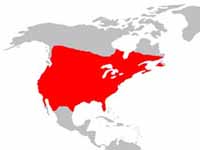

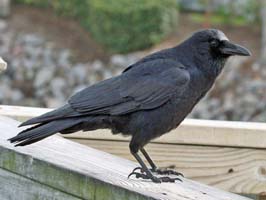
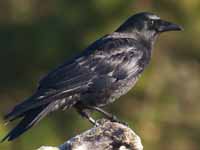

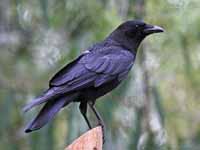

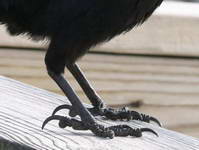
Crow,_Banggai Corvus unicolor Found: Central Sulawesi of Indonesia
The Banggai Crow has black plumage; pale iris; short tail. It is critically endangered.
Image by: 1) Filip Verbelen
Crow,_Bismarck Corvus insularis Found: Bismarck Archipelago (near New Guinea)
The Bismarck Crow has glossy black plumage; large black bill. It was formerly considered subspecies of Torresian Crow.
Image by: 1) hbw.com
Crow,_Bougainville Corvus meeki Found: Bougainville in New Guinea and Solomon Islands
Image by: 1) hbw.com
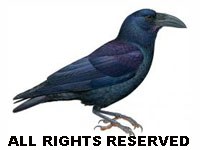
Crow,_Brown-headed Corvus fuscicapillus Found: near New Guinea
The Brown-headed Crow has mainly glossy black plumage; dark brownish-black head, neck; black (male) or reddish-yellow (female) bill.
Image by:
1) Philippe Verbelen
Crow,_Cape also Black Crow Corvus capensis Found: eastern and southern Africa
The Cape Crow has black plumage with slight purple gloss;
Image by: 1) Steve Nova 2) Dave_Curtis 3, 4) Derek_Keats - South Africa

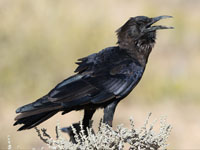

Crow,_Carrion Corvus corone Found: Europe, Asia
Carrion and Hooded Crows were formerly consider races of the same species, Corvus corone. That designation is now assigned to the Carrion Crow, and the Hooded Crow, formerly Corvus corone cornix, has been elevated to Corvux cornix
Image by: 1) Steve Nova 2) Richard_Bartz Dick Daniels - England 3) Dick Daniels - Scotland 4) Bernard_Dupont - Framce 5) L B Tettenborn - germany 6) Andreas_Eichler - Germany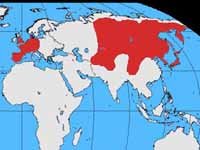


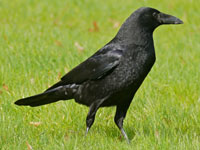


Crow,_Collared Corvus torquatus Found: China
The Collared Crow has mainly black plumage; white mantle, nape, breast band.
Image by: 1) Steve Nova 2, 3, 4) Charles Lam - Hong Kong 
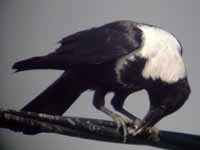


Crow,_Cuban Corvus nasicus Found: Cuba and nearby island
The Cuban Crow has mainly black plumage; dark gray skin behind eye; black legs, bill.
Similar to: Palm Crow. Palm Crow has typical crow "caw". Cuban Crowhas strange liquid bubbling notes and high ringing sounds.
Image by: 1) Jerry_Oldenettel 2) Francesco_VeronesiSimilar to: Palm Crow. Palm Crow has typical crow "caw". Cuban Crowhas strange liquid bubbling notes and high ringing sounds.


Crow,_Fish Corvus ossifragus Found: east and south North America
The Fish Crow is usually found close to water.
Similar to: American Crow. Vocal differentiation is usually the best means of identification. The America Crow does the familiar "caw caw" that we associate with crows while the Fish Crow is more nasal. Visual differentiaion between the two specie is improbable unless there are close enough to allow comparison. In this case note Fish Crows tend to have more slender bills and feet. There may also be a small sharp hook at the end of the upper bill. Fish crows also appear as if they have shorter legs when walking.
Similar to: Northwestern Crow. Their ranges do not overlap, but both species prefer to be near water and like fish / mollusks.
Image by: 1) Steve Nova 2) Phil Brown - Lawrence, Massachusetts 3) e monk - North Carolina
4) Diane Hamilton - New Jersey 5) Don_Faulkner - South CarolinaSimilar to: American Crow. Vocal differentiation is usually the best means of identification. The America Crow does the familiar "caw caw" that we associate with crows while the Fish Crow is more nasal. Visual differentiaion between the two specie is improbable unless there are close enough to allow comparison. In this case note Fish Crows tend to have more slender bills and feet. There may also be a small sharp hook at the end of the upper bill. Fish crows also appear as if they have shorter legs when walking.
Similar to: Northwestern Crow. Their ranges do not overlap, but both species prefer to be near water and like fish / mollusks.
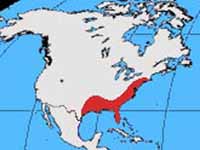


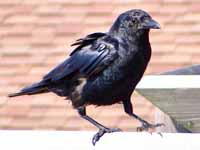

Crow,_Flores Corvus florensis Found: Indonesia
Image by: 1) Ron Knight
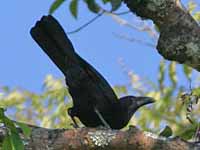
Crow,_Gray Corvus tristis Found: New Guinea
The Gray Crow has mainly black plumage; randomly bleached tail and wing feathers; bare pinkish-white skin around eyes; bluish-white eyes; bluish upper-mandible; some have pinkish-white lower-mandible; others have pinkish-white bill with black tip.
Image by:
1) Steve Nova 2) Jerry Oldenettel - Papua New Guinea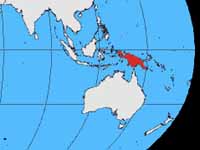

Crow,_Hawaiian Corvus hawaiiensis Found: only in captivity
The Hawaiian Crow has soft brownish-black plumage; long and bristly throat feathers; black bill, legs, feet; thick bill.
Image by: 1) USFWS
Crow,_Hooded Corvus cornix Found: Europe, Asia
The Hooded Crow has mainly ashy-gray plumage; black hooded head, throat, wings, breast marks; black bill, eyes, feet.
Similar to: House Crow, Jackdaw, Hooded Crow's black hood covers all of the head; the others only have black on front part of head.
Image by: 1) JF Bleak 2) Dick Daniels - Scotland 3, 4) Charlie Westerinen - Poland 5) Andreas_Trepte 6) hedera.baltica - Poland 7) Lip Kee - Egypt 8) Video by Avibirds. More vidoesSimilar to: House Crow, Jackdaw, Hooded Crow's black hood covers all of the head; the others only have black on front part of head.
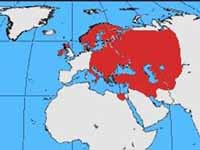



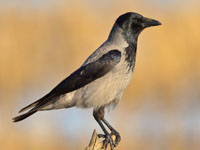

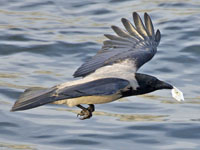

Crow,_House Corvus splendens Found: Asia, Africa, Australasia
The House Crow has black crown, forehead, throat, wings, tail; gray-brown neck, underparts.
Similar to: Hooded Crow, Hooded Crow's black hood covers all of the head; House Crow only has black on front part of head.
Similar to: Jackdaw. House Crow has much larger bill with a round end; Jacksaw has short pointed bill.
Image by: 1) Laurens 2) Benjamint444 - Pokhara, Nepal 3) Darren
Bellerby - Thane Creek, Mumbai,
India 4) Dick Daniels - NepalSimilar to: Hooded Crow, Hooded Crow's black hood covers all of the head; House Crow only has black on front part of head.
Similar to: Jackdaw. House Crow has much larger bill with a round end; Jacksaw has short pointed bill.


Crow,_Jamaican Corvus jamaicensis Found: Jamaica
The Jamaican Crow is a relatively small sized crow with dark gray plumage. primarily a bird of hill and mountain forest, The iris is either grey-brown or red-brown, possibly depending on age. Legs and feet are black. It comes down to lower elevations during the dry season where it is more likely to be seen.
Image by: 1) Jecowa 2) Philip Gosse 3) Ron Knight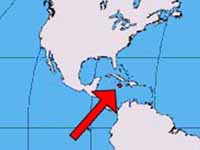
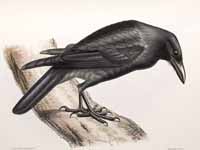

Crow,_Large-billed also Jungle Crow Corvus macrorhynchos Found: Asia
The Large-billed Crow has black plumage; very large bill. Variabe sized - some subspecies larger than Carrion Crow, some smaller.
Image by: 1) Steve Nova 2) Allan Hopkins- India 3) Sergey Yeliseev 4) Francisco_Restivo - Toyko



Crow,_Little Corvus bennetti Found: Australia
The Little Crow has black plumage, bill, legs, feet.
Similar to: Torresian Crow. Little Crow is slightly smaller and has a slightly smaller bill than Torresian Crow. Torresian Crow's head is darker than body; Little Crow's head and body about the same darkness.
Image by: 1) Steve Nova 2) Keith Edkins 3) Ron_n_Beth_Pixs Similar to: Torresian Crow. Little Crow is slightly smaller and has a slightly smaller bill than Torresian Crow. Torresian Crow's head is darker than body; Little Crow's head and body about the same darkness.
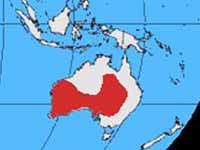


Crow,_Long-billed Corvus validus Found: Maluku Islands of Indonesia
The Long-billed Crow has glossy black plumage; l long bill; white iris.
Image by: 1) Paulo Alves 2) James_Eaton 3) Sam_Woods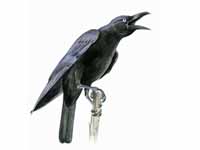


Crow,_Mariana Corvus kubaryi Found: northern Marianas Islands, Guam, and vicinity
The Mariana Crow has mainly greenish-black glossy plumage; bluish-black glossy tail.
Image by: 1) USGS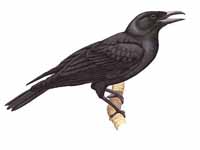
Crow,_New Caldonian Corvus moneduloides Found: New Caldonia (islands east of Australia)
The New Caldonian Crown has glossy black plumage; black bill, legs, feet. Makes a qua-qua sound.
Image by: 1) Steve Nova 2) Corvus_moneduloides 3) Natalie Uomini2) Juvenile

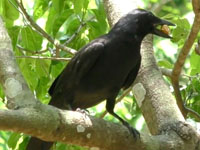

Crow,_Northwestern Corvus caurinus Found: Pacific coastal area from Washington to Alaska
The Northwestern Crow is usually found close to water.
Similar to: American Crow. If found in Alaska, then it is a Northwestern Crow. Northwestern Crow is smaller than American Crow and often has a messier appearance. However, the species can be very difficult to distinguish by appearance. Northwest Crow has a more nasal call.
Similar to: Fish Crow. Their ranges do not overlap, but both species prefer to be near water and like fish / mollusks.
Image by: 1) Steve Nova 2) Alan D Wilson 3) Elaine R Wilson - near Victoria, British
Columbia 4) Dick Daniels - Seward, Alaska 5, 6, 7) Dick - Homer, Alaska Similar to: American Crow. If found in Alaska, then it is a Northwestern Crow. Northwestern Crow is smaller than American Crow and often has a messier appearance. However, the species can be very difficult to distinguish by appearance. Northwest Crow has a more nasal call.
Similar to: Fish Crow. Their ranges do not overlap, but both species prefer to be near water and like fish / mollusks.



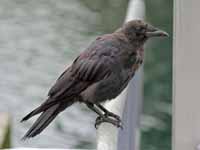
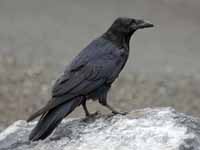
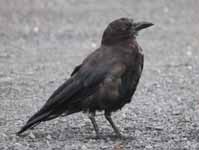
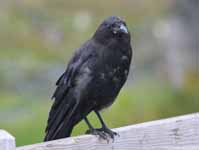
Crow,_Palm Corvus palmarum Found: Cuba, Hispaniola
The Palm Crow is a relatively small black crow, similar to the Fish Crow of the east coast of USA. It has a simple and repetitive call cao.
Similar to: Cuban Crow. Palm Crow has typical crow "caw". Cuban Crowhas strange liquid bubbling notes and high ringing sounds.
Similar to: White-necked Crow. The White-necked Crow is larger than the Palm Crow. The orange-red eyes of White-necked Crow is the easiest way to identify it. It also has many diffeerent vocalizaitons, compare to the Palm Crow's simple coa.
Image by: 1, 2) Black Crow 3, 4) Jerry Oldenettel - CubaSimilar to: Cuban Crow. Palm Crow has typical crow "caw". Cuban Crowhas strange liquid bubbling notes and high ringing sounds.
Similar to: White-necked Crow. The White-necked Crow is larger than the Palm Crow. The orange-red eyes of White-necked Crow is the easiest way to identify it. It also has many diffeerent vocalizaitons, compare to the Palm Crow's simple coa.
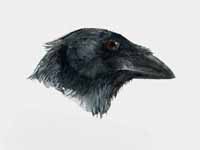

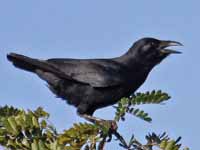

Crow,_Pied Corvus albus Found: Africa
The Pied Crown has mainly black plumage, bill, legs; white shoulders, breast.
Similar to: White-necked Raven. Pied Crow has much more white than White-necked Raven.
Image by: 1) Engineer111 2, 3) Dick Daniels near Hluhluwe-Umfolozi Game Reserve, South Africa 4) Dick - Madagascar 5, 6, 7) Dick - Tanzania 8) Cristiano Crolle - Etosha Nat.Park, Namibia Similar to: White-necked Raven. Pied Crow has much more white than White-necked Raven.
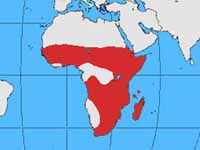


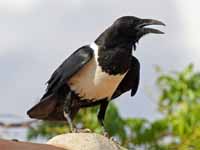


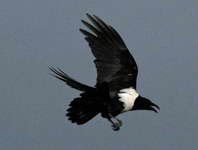

Crow,_Piping Corvus typicus Found: Sulawesi (Indonesia)
Image by: 1) Black Crow 2) Francesco Veronesi 3) Peter_Ericsson

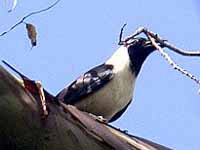

Crow,_Sinaloa Corvus sinaloae Found: Mexico
The Sinaloa Crow has glossy purple-black plumage with black bill, legs; pale throat.
Similar to: Tamaulipas Crow. The Sinaloa Crow has pale throat; Tamaulipas Crow has black throat.
Image by: 1) Steve Nova 2) Dominic Sherony 3) Jorge_MontejoSimilar to: Tamaulipas Crow. The Sinaloa Crow has pale throat; Tamaulipas Crow has black throat.



Crow,_Slender-billed Corvus enca Found: Brunei, Indonesia, Malaysia, and the Philippines.
Image by: 1) Black Crow 2) AS Kono - North Sulawesi 3) David_Meade - Sulawesi
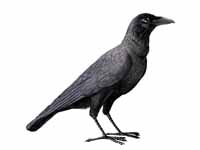


Crow,_Somali also Dwarf Raven Corvus edithae Found: east Africa
The Somali Crow has brownish black plumage.
Similar to: Brown-necked Raven. Brown-necked Raven is larger than Somali Crow. They can be differentiated by voice.
Image by: 1) Steve Nova 2, 3) Sergey Yeliseev - EthiopiaSimilar to: Brown-necked Raven. Brown-necked Raven is larger than Somali Crow. They can be differentiated by voice.



Crow,_Tamaulipas Corvus imparatus Found: North America (Texas), northern Mexico
The Tamaulipas Crow has glossy dark, bluish plumage, which appears soft and silky. The bill is quite slender and black, as are the legs and feet.
Similar to: Sinaloa Crow. The Sinaloa Crow has pale throat; Tamaulipas Crow has black throat.
Image by: 1, 2) Steve nova 3) Jerry Oldenettel - Texas 4) Howard_Patterson - TexasSimilar to: Sinaloa Crow. The Sinaloa Crow has pale throat; Tamaulipas Crow has black throat.


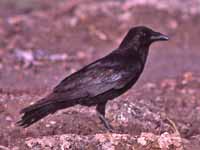

Crow,_Torresian Corvus orru Found: Australia, New Guinea
The Torresian Crow has glossy black upperparts; black head, underparts; white iris; white (seen when ruffled by wind) base of head and neck. The Bismarck Crow was formerly considered subspecies of Torresian Crow.
Similar to: Little Crow. Little Crow is slightly smaller and has a slightly smaller bill than Torresian Crow. Torresian Crow's head is darker than body; Little Crow's head and body about the same darkness.
Image by: 1) Steve Nova 2) Richard McDonald 3) Lip Kee - Northern Territory 4) Dave Curtis - Brisbane 5) Charlie Westerinen - Nossa Heads, Australia Similar to: Little Crow. Little Crow is slightly smaller and has a slightly smaller bill than Torresian Crow. Torresian Crow's head is darker than body; Little Crow's head and body about the same darkness.
2) Bird on left has white visible on its neck.
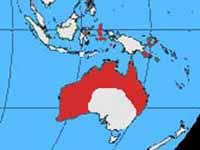


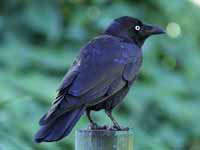

Crow,_White-billed also Guadalcanal Crow Corvus woodfordi Found: Solomon Islands (east of Papua New Guinea)
The White-billed Crow has an ivory colored bill with black tip; mainly glossy black plumage; darker head with greenish-purple gloss.
Image by: 1) William Hart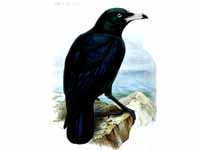
Crow,_White-necked Corvus leucognaphalus Found: Hispaniolaa
The White-necked Crow has all black plumage; orange-red eyes. The white base of the neck feathers is rarely visible.
Similar to: Palm Crow. The White-necked Crow is larger than the Palm Crow. The orange-red eyes of White-necked Crow is the easiest way to identify it. It also has many diffeerent vocalizaitons, compare to the Palm Crow's simple coa.
Image by: 1) ZankaM - Dominican Republic 2, 3) Ron Knight - Dominican RepublicSimilar to: Palm Crow. The White-necked Crow is larger than the Palm Crow. The orange-red eyes of White-necked Crow is the easiest way to identify it. It also has many diffeerent vocalizaitons, compare to the Palm Crow's simple coa.
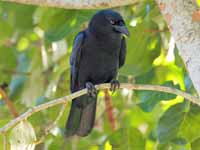


Jackdaw also Eurasian Jackdaw also Western Jackdaw Corvus monedula Found: northeast North America (vagrant), Europe, Asia, Africa
The Eurasian Jackdaw has black on center of head; black throat, wings; gray nape, back, underparts; light gray eyes
Similar to: Daurian Jackdaw. Western Jackdaw has light iris; Daurian has dark iris.
Similar to: Hooded Crow, Hooded Crow's black hood covers all of the head; Jackdaw only has black on front part of head.
Similar to: House Crow. House Crow has much larger bill with a round end; Jacksaw has short pointed bill.
Image by: 1) Sergey Yeliseev - Moscow region 2) Charlie Westerinen 3) Placid Casual 4) MatthiasKabel 5) Maxwell Hamilton - England 6) Dick Daniels - Scotland 7) Agustin_Povedano 8) Olivier Klein - Netherlands Similar to: Daurian Jackdaw. Western Jackdaw has light iris; Daurian has dark iris.
Similar to: Hooded Crow, Hooded Crow's black hood covers all of the head; Jackdaw only has black on front part of head.
Similar to: House Crow. House Crow has much larger bill with a round end; Jacksaw has short pointed bill.
1) Juvenile

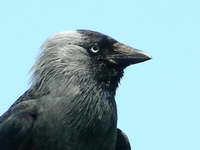
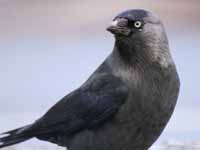
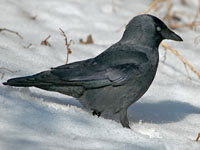



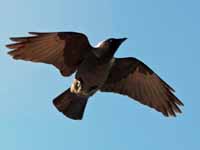
Jackdaw, Daurian Corvus dauuricus Found: Asia
Some Daurian Jackdaw have large areas of creamy white around lower parts extending around neck as broad collar. Darker adults resemble the Western Jackdaw. All have dark iris.
Similar to: Western Jackdaw. Western Jackdaw has light iris; Daurian has dark iris.
Similar to: Hooded Crow, Hooded Crow's black hood covers all of the head; Hooded Jackdaw only has black on front part of head.
Image by:
1) Steve Nova 2) Libero Guerro 3) Sergey Yeliseev 4) Charles Lam - Penfold Park at Hong Kong 5) Hiyashi_HakaSimilar to: Western Jackdaw. Western Jackdaw has light iris; Daurian has dark iris.
Similar to: Hooded Crow, Hooded Crow's black hood covers all of the head; Hooded Jackdaw only has black on front part of head.
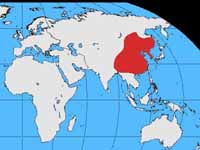



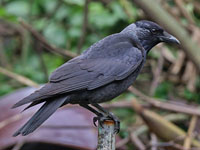
RAVENS
A raven is one of several larger-bodied members of the genus Corvus. Most have black plumage and large beaks but their plumage can differ slightly in some species. Most species have dark brown irises but a few in Australia have white irises.
Raven,_Australian Corvus coronoides Found: Australia
The Australian Raven has glossly black plumage with a blue-purple to blue-green sheen depending on the light; black feet, bill. Thick black plumage on throat resembles a beard. Adult has white eye; juvenile black eye.
Similar to: Little Raven. Australian Raven has bigger bill than the Little Raven.
Image by: 1) Steve Nova 2, 3) Dick Daniels - Australia 4) Brett_DonaldSimilar to: Little Raven. Australian Raven has bigger bill than the Little Raven.



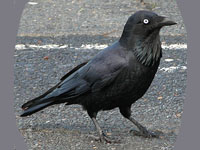
Raven,_Brown-necked Corvus ruficollis Found: North Africa, Asia
The Brown-necked Raven has brownish-black head, neck; rest of plumage is glossy black with purplish-blue gloss.
Similar to: Somali Crow. Brown-necked Raven is larger than Somali Crow. They can be differentiated by voice.
Image by: 1) Steve Nova 2, 3) Yip Kee - Egypt 4) Marcel HolyoakSimilar to: Somali Crow. Brown-necked Raven is larger than Somali Crow. They can be differentiated by voice.
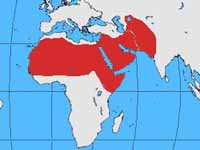


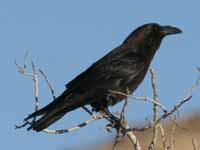
Raven,_Chihuahuan Corvus cryptoleucus Found: The Southwest USA, Mexica
Similar to: Common Raven. The Chihuahuan Raven is considerably smaller than the Common Raven, has longer bristles along the upper bill, and has a shorter bill.
Image by: 1) Steve Nova 2, 3) Quinn Dombrowski - Arizona 4) Jerry Oldenettel - Arizona
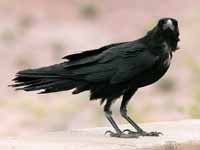


Raven,_Common Corvus corax Found: North America, Europe, Asia, Africa
Apart from its greater size, the Common Raven differs from its cousins, the crows, by having a larger and heavier, black beak, shaggy feathers around the throat and above the beak, and a wedge-shaped tail.
Similar to: Chihuahuan Raven. The Chihuahuan Raven is considerably smaller than the Common Raven, has longer bristles along the upper bill, and has a shorter bill.
Similar to: Rook. Rook has gray at base of bill; Common Raven has completly black bill.
Image by: 1) Hogroth 2) Dick Daniels - Arizona 3, 4, 45) Dick - Wyoming 6) Dick - Napel 7) Jan_Svetlik 8) Video by Avibirds. More vidoesSimilar to: Chihuahuan Raven. The Chihuahuan Raven is considerably smaller than the Common Raven, has longer bristles along the upper bill, and has a shorter bill.
Similar to: Rook. Rook has gray at base of bill; Common Raven has completly black bill.








Raven,_Fan-tailed Corvus rhipidurus Found: Asia, Africa
The Fan-tailed Raven has black plumage, bill, legs, feet. Plumage has a purplish-blue gloss in good light. Base of feathers on upper neck are white, but only seen in windy conditions.
Image by: 1) Steve Nova 2) Francesco_Veronesi - Kenya 3) Charles_J_Sharp - Ethiopia 4) Lip_Kee - Ethiopia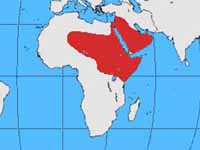

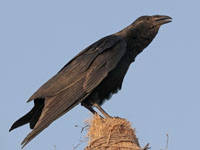
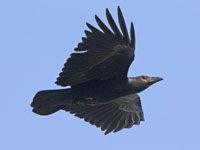
Raven,_Forest Corvus tasmanicus Found: Australia
The Forest Raven has glossy black plumage; white eye. It is the only Corvus in Tasmania.
Image by: 1) JJ Harrison 2) Ron Knight 3) Nik_Borrow - Tasmania
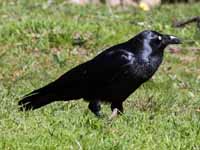

Raven,_Little Corvus mellori Found: Australia
The Little Raven has glossy black plumage; black bill, legs; white eyes.
Similar to: Australian Raven. Australian Raven has bigger bill than the Little Raven.
Image by: 1) Steve Nova 2) Charlie Westerinen - Botany Bay 3) Toby Hudson 4) David Jenkins 5) Kym_FarnikSimilar to: Australian Raven. Australian Raven has bigger bill than the Little Raven.

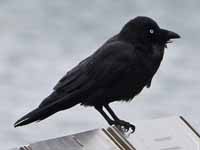



Raven,_Thick-billed Corvus crassirostris Found: Ethiopia, Eritrea, and nearby
The Thick-billed Raven has mainly black plumage; large thick black bill with white tipl; white patch on rear of neck.
Image by: 1) Steve Nova 2) A_Davey 2) Ondrej Zvacek 3) Donald_Macauley - Ethiopia 5) Lip_Key1) Pair



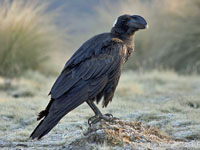

Raven,_White-necked Corvus albicollis Found: Africa
The White-necked Raven is predominantly black. It has white semi-collar on back of neck; black bill has white tip.
Similar to: Pied Crow. Pied Crow has much more white than White-necked Raven.
Image by: 1) Vblase 2) Dick Daniels - specimen in Nairobi National Museum, Kenya 3) Greg Hume - Cincinnati Zoo 4) David
Schenfeld - Rwanda 5) Cristiano Crolle - Knysna, South AfricaSimilar to: Pied Crow. Pied Crow has much more white than White-necked Raven.
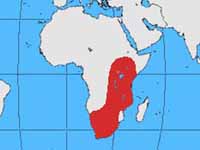
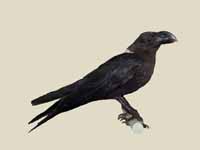
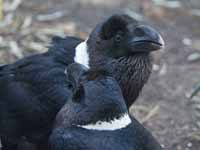
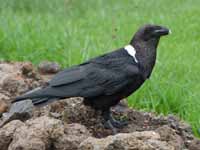

Rook Corvus frugilegus Found: Europe, New Zealand (introduced)
The Rook has black plumage which may have blue to purple sheen in the sunlight. It has large, pointed bill with bare gray-white skin around base of bill and near the eyes.
Similar to: Common Raven. Rook has gray at base of bill; Common Raven has completly black bill.
Image by: 1) Adrian Benko 2) Dick Daniels - England 3) Dick - Scotland 4) Dick - Scotland 5) Jan_SvetlikSimilar to: Common Raven. Rook has gray at base of bill; Common Raven has completly black bill.




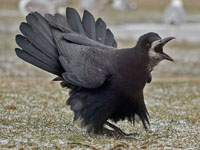
Genus Pyrrhocorax
The choughs are resident in the mountains.. They have long broad wings and perform spectacular aerobatics. They build a lined stick nest and lay three to five eggs. They feed, usually in flocks, on short grazed grassland, taking mainly invertebrate prey, supplemented by vegetable material or food from human habitation, especially in winter.
Chough,_Alpine also Yellow-billed Chough Pyrrhocorax graculus Found: Europe, Asia, Africa
The Alpine Chough has glossy black plumage; yellow bill; red legs.
Image by: 1) Gunter Hildebrandt 2) Mathias
Bigge - Austria 3) Charlie Westerinen - Eiger, Switzerland 4) Imran_Shah - Pakistan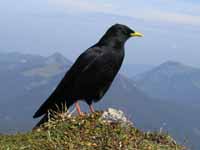
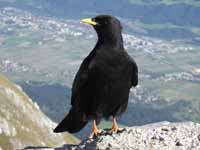


Chough,_Red-billed Pyrrhocorax pyrrhocorax Found: Europe, Asia, Africa
The Red-billed Chough has glossy black plumage; long curved red bill; red legs.
Image by: 1) Yomangani 2) Malte Uhl 3) Dibyendu Ash - India 4) Paul Roberts - Wales2) Pyrrhocorax Pyrrhocorax barbarus 3) P. p. himalayanusone
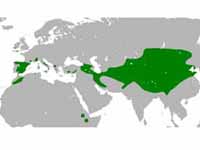
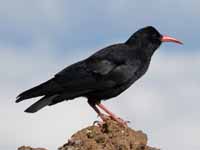


Genus Zavattariornis - 1 species
Crow,_Stresemann's Bush- Zavattariornis stresemanni Found: southern Ethiopia
The Stresemann's Bush-Crow has mainly bluish-gray plumage; creamy-white throat, breast; glossy black wings; brown eye surrounded by bright blue skin. Resembles a starling, but DNA suggests it belongs to the crow family.
Image by: 1) Steve Nova 2) Dick Daniels - specimen in Nairobi National Museum, Kenya 3) Sandy Wall - Ethiopia
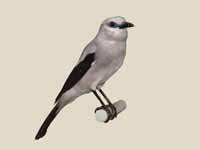

The Mudnesters contain just two species: the Apostlebird and the White-winged Cough. Both species are very social and spend time in leaf litter searching for food. They build their nests out of mud.
Genus Corcorax - 1 species
Chough,_White-winged Corcorax melanorhamphos Found: Australia
The White-winged Chough has black plumage; red eyes; thin down-curved bill. In flight, there is obvious white on the wings, thus the name. It resembles in shape the Alpine Chough,_but this is due to convergent evolution.
Image by: 1) David Cook 2) David_Jenkins 3) Patrick K59 4) birdsaspoetry
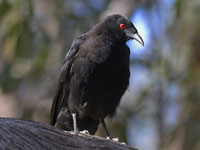


Genus Struthidea - 1 species
Apostlebird Struthidea cinerea Found: Australia
The Apolstlebird has predominantly gray plumage; long black tail; brownish wings; black bill, legs. Its name relates to the tendency to travel in flocks of about 12 birds.
Image by: 1) Laurie_Boyle 2)
David Cook - Dubbo, NSW,
Australia 3) Arthur_Chapman 4) Charlie Westerinen - Australia

